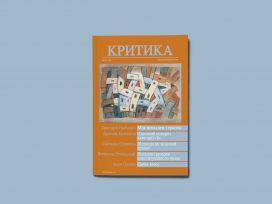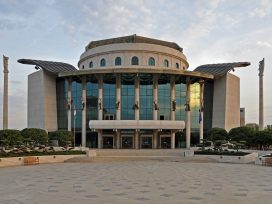Beginnings
During the romantic 19th century, even at the beginning of the 20th, art legends were born in the attics and garrets, preferably Parisian. During the more practical decades of the late 20th century, artists relocated to much more prosaic places, such as the smoke-filled cellars of Liverpool (The Beatles) or the garages and student dormitories of the American West Coast, populated by computer magicians and IT wizards. The great legend of the Lithuanian theatre was born in a warehouse in Vilnius, more specifically, in the section of the Youth Theatre used both as a workshop and a warehouse in which stage decorations were stored. Nowadays, the building – a newly redecorated palace, originally built during the 15th and 17th centuries by the Radziwiłł family – is difficult to recognize and hosts the Museum of Lithuanian Theatre, Music and Cinema. In the 1970s, it was a dilapidated structure, despite the fancy name – Experimental Stage of the Youth Theatre – given to one of its decrepit halls. It was this stage, the most modest among the Lithuanian theatres of the time, that was chosen by Eimuntas Nekrošius for his debut as a theatre director in 1977. Then a student of GITIS, the Lunacharsky State Institute for Theatre Arts in Moscow (renamed the Russian Institute of Theatre Arts in 1991), Nekrošius directed his diploma performance A Taste of Honey (Medaus skonis) with the troupe of the Youth Theatre.
The debut production was modest, too, but also incredibly meticulous, starting with the choice of playwright. It may have seemed that Shelagh Delaney, of England’s ‘angry young men’ generation, wrote this ‘kitchen sink’ drama specifically for the Experimental Stage of the Youth Theatre, whose poverty Nekrošius did not even attempt to conceal, as if with a nod of acknowledgement to the great innovator of 20th-century theatre Jerzy Grotowski and his Poor Theatre. Delaney’s characters became the predecessors of the figures Nekrošius would later persistently put on centre stage – subjugated outsiders, hurt and humiliated, whose social status overshadows their humanity and the beauty of their soul.
In Nekrošius’s rendition, the irony of the title of A Taste of Honey was further underscored by a very mundane detail: during the second part of the performance, the room would be filled with a pervasive smell – not of honey, but of cigarette smoke, whose clouds would waft in from the foyer, in which the audience smoked during the interval (back then, all of us, young and old, men and women, smoked like crazy). The performance would begin in complete darkness with only a few cigarettes flickering on stage, but their light was too weak to pierce the darkness or warm up the relationships between the characters. Still, it was a flash of hope, a candle in the dark.
The young director was right to have selected the actors of the Youth Theatre, although he could hardly have chosen anyone else. His was a return of one of their own. Eimis (Eimuntas Nekrošius’s pet name, given to him during his student years by his friends and theatre people) had been eagerly awaited by his first teacher of stage art, Dalia Tamulevičiūtė, who taught at the Department of Acting at the Conservatoire (now the Lithuanian Academy of Music and Theatre), and his former course-mates, the ten actors whom Tamulevičiūtė had trained and brought to the Youth Theatre, then managed by her.
‘The Ten’ of the Youth Theatre – the actors trained by Tamulevičiūtė – could have just as easily been ‘The Eleven’ (by the way, the young men loved, and were extremely good at, football), but Tamulevičiūtė soon noticed that one student in her group kept creating intricate mise en scènes, very different from what she was instructing her students to do. I do not know how long it took her to persuade him, but after he finished his first two years at the Conservatoire, Eimis left for GITIS to become a theatre director.
Therefore, upon his return to Lithuania, Nekrošius did not have to navigate the tricky waters of the Youth Theatre in order to avoid the reef which had sunk many a director – distrust on the part of the troupe. The latter was a group of distinct and very self-confident young individuals, with their own understanding of the theatre and rehearsal methods, even the criteria of acting excellence. What made Nekrošius’s debut as a director so distinctive was the perfect harmony he achieved between directing and acting. It is the happiest moment in the theatre when the director’s and the actors’ hearts beat in sync. A Taste of Honey was a first step towards the greatest roles of their lives for the actors Dalia Overaitė, Algirdas Latėnas and Vidas Petkevičius.
After he completed his studies in Moscow, Nekrošius was appointed to Kaunas Drama Theatre, where he directed The Ballads of Duokiškis (Duokiškio baladės) by Sauliaus Šaltenis and Ivanov by Anton Chekhov (both 1978). His second return to the Youth Theatre in 1980, the performance A Cat Behind the Door (Katė už durų), based on Grigory Kanovich’s text, was not as triumphant as had been expected. Nonetheless, triumph was around the corner.
In 1975, the Youth Theatre had undergone a renewal, marked by the employment of Tamulevičiūtė’s ‘The Ten’ and of Saulius Šaltenis, who went on to become not only the theatre’s major playwright, but also its guru, something of a spiritual leader for the entire troupe. For five subsequent years, particularly after its first very successful tour in Moscow in 1978, the theatre was constantly in the limelight. It could continue exploiting the gold mine of texts created by Šaltenis; however, both the theatre and its gifted actors soon began to long for new ideas. The troupe was characterized by free thinking and irony, introduced by Šaltenis, whose targets were the persistent lies, empty extravagant phrases, pathos and artificially heroic poses so beloved by Soviet culture, aiming to cover up the reality, which was far from heroic. The actors of the Youth Theatre needed directors who would offer new, more complicated tasks and greater challenges. Their well-trained imagination, their improvisational nature, the flexibility of their bodies and minds, even the entire atmosphere of the Youth Theatre urged them to constantly seek new things. Nekrošius, on the other hand, badly needed actors who would share his ideas. In 1980, these circumstances begat a chef-d’oeuvre, the performance of The Square (Kvadratas) directed by Nekrošius.
The great explosion
During the six years between 1980 and 1986 at the Youth Theatre, Nekrošius directed five masterpieces: The Square (1980), Pirosmani, Pirosmani… (1981), Love and Death in Verona (Meilė ir mirtis Veronoje) (1982), The Day Lasts More Than a Hundred Years (Ilga kaip šimtmečiai diena) (1983), and Uncle Vanya (Dėdė Vania) (1986). His last production at the Youth Theatre, The Nose (Nosis) by Nikolai Gogol (1992) was suddenly very different; it was somewhat of a postscript by Nekrošius, a painfully ironic commentary on himself and the entire period which had just come to an end.
The Square was not just another brilliant performance. It was an absolutely new theatre, never seen before. The new theatrical language allowed Nekrošius to create an epic theatrical phenomenon out of a sentimental didactic novella by Valentina Eliseeva, titled ‘This Is How It Was…’ and depicting a criminal who is reformed by a young teacher and active member of the Komsomol. Next in the line was a mediocre play by Vadim Korostylyov, Pirosmani, Pirosmani…. Both texts were fundamentally rewritten by Šaltenis, who sat next to Nekrošius during the rehearsals; Šaltenis is the real author of the monologues and occasional asides in these performances. For Nekrošius, a literary text typically served to provide a topic, which he then developed on stage using non-verbal means, sound and movement. In Nekrošius’s performances, the actors often say much more by using physical actions and body language, rather than dialogues.
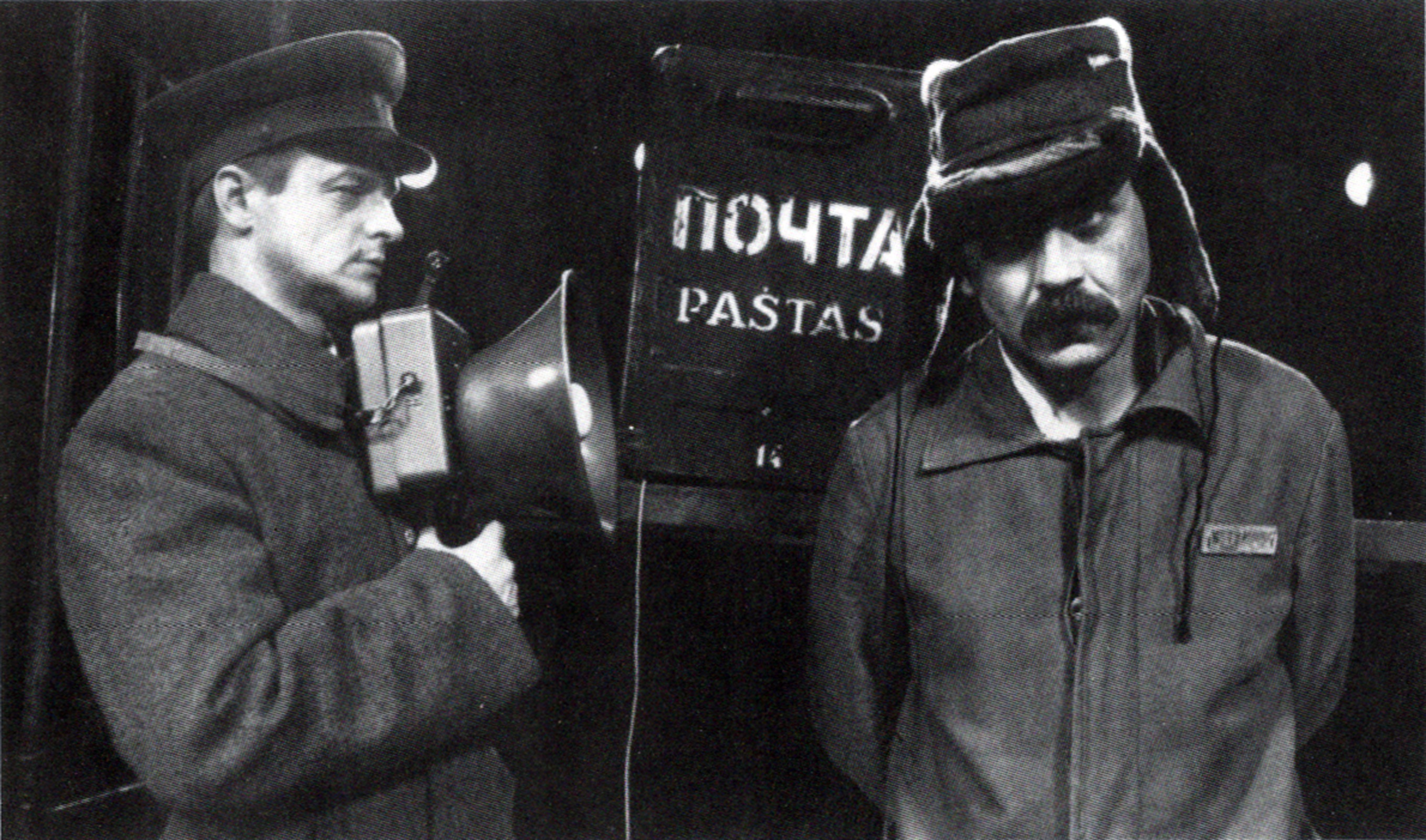
‘The Square’ (dir. Eimuntas Nekrošius); Remigijus Vilkaitis as the Warden (l), and Kostas Smorginas as He (r). Photo: Courtesy of Kultūros barai.
Several instances of this wordless but eloquent acting are impossible to forget. I am thinking, for example, of the dumb Guard played by Vidas Petkevičius in Pirosmani, Pirosmani…, whose only tool of communication was an empty bottle, which made mysterious sounds when the Guard blew into it. The Clown by Remigijus Vilkaitis (Love and Death in Verona), a true ode to the actor’s profession, framed the Shakespearean plot by employing the ‘theatre within the theatre’ principle and commented on the action without any words, using only facial expressions; this characteristically Italian comedian, a vagabond with a suitcase, a Maestro loyal to the theatre, may have predicted Nekrošius’s successful career in Italy in the early years of the 21st century. The role of a mankurt by Saulius Bareikis (The Day Lasts More Than a Hundred Years) managed to convey, exclusively through pantomime, what happens when a human being’s and a nation’s memory is destroyed. The lazzo (Uncle Vanya), those brazen, passionate beings who polished the parquet of professor Serebryakov’s estate – to the loud applause of the most diverse audiences in different countries – deserve a special mention. These servants, imagined and put on stage by Nekrošius, were a remarkable episode in the long career of experienced actors Rimgaudas Karvelis, Jūratė Aniulytė and Vytautas Taukinaitis, who did not utter a single word during the entire performance.
By the early 1980s, the word had been totally compromised by socialist realism, Soviet campaigning and propaganda. In Nekrošius’s hands, however, the humbug of Soviet parading became the building blocks for The Square. Energetic marches, Mayakovsky’s poems, the over-the-top enthusiasm of the Komsomol youth, slogans transmitted through megaphones, all of this would be transformed into mere noise – whistles from a train and the rattle of the wheels on a railway, punctuated by shrill commands, emitted from the megaphones at the labour camps of the Gulag. For a live human voice, undistorted by megaphones and microphones, to resound again, deadly silence had to prevail, the silence of the universe, as if the old world had ended to give way to a new one.
The central character in The Square, a nameless He played by Kostas Smoriginas, was a remarkable accomplishment on the actor’s part. With a haphazardly donned ushanka hat, its ear-flaps pulled down, and a square loaf of bread in his hands, He was a generalized picture of the zek, an inmate of the infinite Soviet Gulag: it was as if the famous sculpture by a Gulag martyr Leonid Nedov had come to life and stepped onto the stage. Everything in The Square, even the breathing of He, was controlled by the Leader, played by Remigijus Vilkaitis, who stood for the numerous guards, supervisors, jailers, convoyeurs, politruks, functionaries, and other officials of the repressive state and the largest ‘prison industry’ in the world, developed by the Soviets.
In front of our eyes, Smoriginas’s He (zeks did not have names and were referred to by numbers) was reduced to a tabula rasa – a clean slate, the soul of a child, who had to relearn how to live and to re-establish his severed ties with the world; hence a child’s bed, placed on the stage of The Square. Overcome by childish belief and hope, He would attempt to communicate with a post-box or a can as if they were living beings and would then turn the can into a radio receiver (nowadays, He would probably conjure up a mobile phone).
At the same time, a brutal conflict was unfolding between Him and a prison guard, one which would culminate in the victory of the prisoner. With the help of the radio and a post-box, He overcame the walls of his prison cell as well as the endless vastness of Siberia, which had kept him isolated, and received a response from another human being, Her (Janina Matekonytė and Dalia Overaitė). In exchange, instead of sugar, the most precious possession of the prisoner (in Soviet prisons and labour camps, pieces of sugar were used as a kind of currency), He gave Her his heart. The mis-en–scène was extremely poetic, but also very unsettling, setting the love scene, which was covered in a rain of sugar cubes, in the most unfitting of places, the brutal environment of the prison.
Pirosmani (Vladas Bagdonas), a self-taught Georgian painter full of dreams to amaze Paris, also found himself in a hostile world, in which he could converse only with the dumb Guard (Vidas Petkevičius). The performance would begin in complete darkness, with a reading of an excerpt from the Georgian poem ‘The Knight in the Panther’s Skin’ by Shota Rustaveli. Then, from behind Pirosmani’s dark shop window, human figures would begin to emerge, of people whom he had met and dreamed about, had remembered and painted.
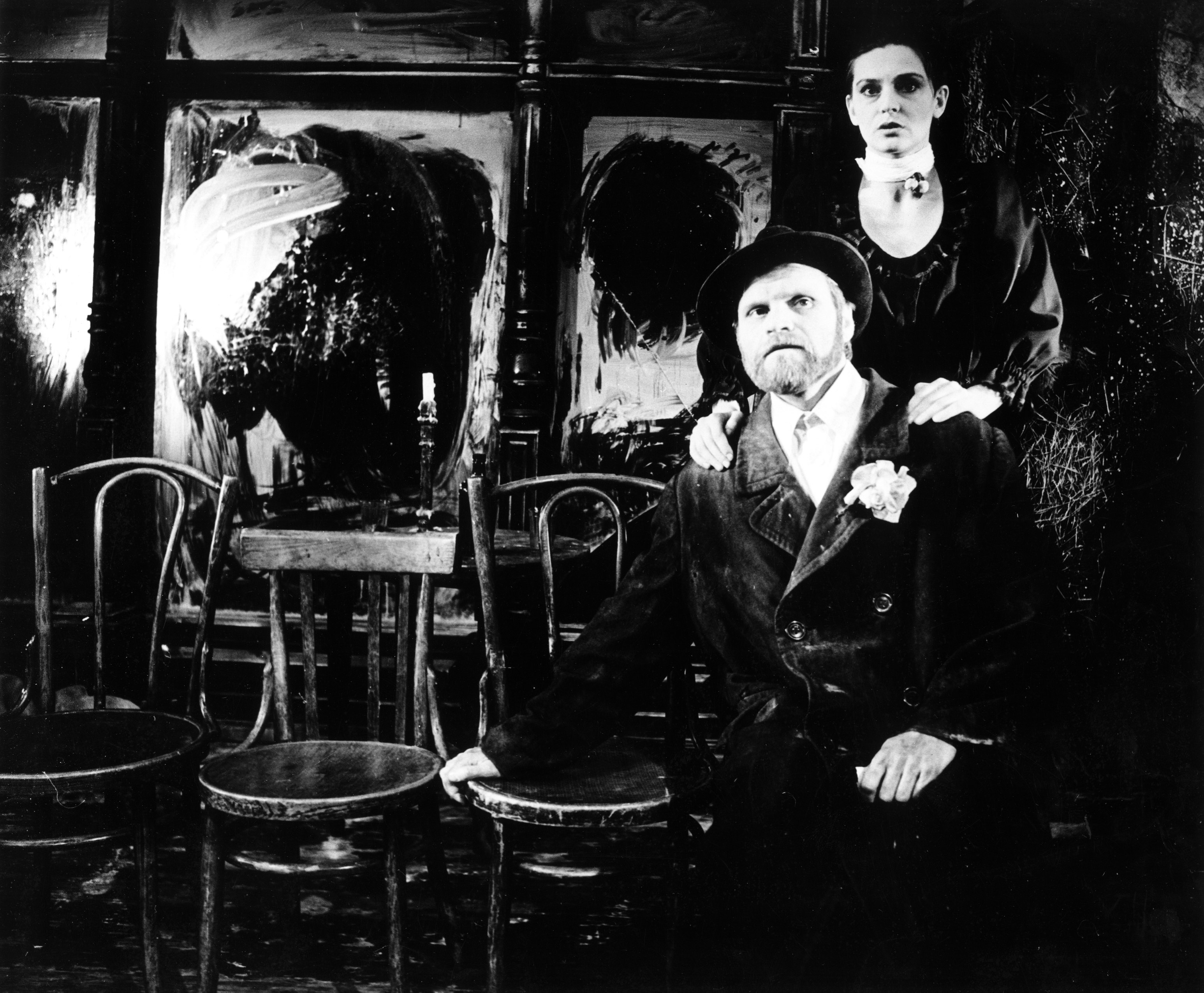
‘Pirosmani, Pirosmani …’; Vladas Bagdonas as Pirosmani (l), and Irena Kriauzitė as Iya-Maria. Photo: Courtesy of Kultūros barai.
The stunningly beautiful window of Pirosmani’s shop – and of his dream world – created by scenographer Adomas Jacovskis was reminiscent of the doors and gates as described by the 20th century British thinker Clive Staples Lewis: they allow humans to look beyond nature. As Lewis puts it, ‘But all our confidence that Nature has no doors, and no reality outside herself for doors to open on, would have disappeared.’ In the performance Pirosmani, Pirosmani…, the door to the otherworld (eternity) did indeed open, and, very fittingly, the audience would see a miniature Georgian church in the finale.
Nekrošius constructed the fragile poetic space of the performance in his usual manner, using very simple objects. Bagdonas’s Pirosmani brought his best and only friend a gift of an Easter egg, wrapped in gilded paper. In another scene, he carried an intricate pyramid of simple chairs, a celebration of his loneliness. Before his death, Iya-Maria (Irena Kriauzaitė) smeared Pirosmani’s soles with black shoe polish. The Guard transported Pirosmani from this vale of tears to a heavenly homeland, having lugged his body onto scales and dusted him with white flour, suggestive of resurrection.
After these productions, set on the small stage at the Youth Theatre, Nekrošius moved on to monumental forms. The rock opera Love and Death in Verona, based on William Shakespeare’s Romeo and Juliet, for which Kęstutis Antanėlis composed the music and Sigitas Geda wrote the libretto, began as a medieval mystery play about the secrets of love and death, which elevated Juliet (played by Violeta Podolskaitė, Kristina Kazlauskaitė and Janina Matekonytė) to the status of the Madonna. However, the mystery soon turned into a carnival, even a burlesque. The omnipotent Prince of Verona (Antanas Šurna and Arūnas Storpirštis) turned into a midget, and Romeo (Kostas Smoriginas), accompanied by his rascal friends burst into a crowd of Veronesi, wearing stilts. Audacious Romeo then bravely stepped on a precarious keyboard-bridge to meet Juliet, his fate, while the chorus on stage – and the audience in the theatre – looked on, breathless.
The polyphony of the high (medieval mystery, tragedy, drama) and the low (burlesque, farce, comedy) enriched Nekrošius’s other performances as well, for instance, The Day Lasts More Than a Hundred Years and Uncle Vanya, both marked by tragic existential undertones. A grand sacral funeral procession to the ancient Ana Beiit Cemetery in The Day Lasts More Than a Hundred Years was accompanied by two jesters, the deceased Kazangap’s son (Arūnas Storpirštis) and son-in-law (Juozas Jaruševičius), who could not stop quarrelling. The most intense and candid confession scenes in Uncle Vanya were repeatedly unsettled by clumsy, fat Vaflya (Juozas Pocius), who would keep appearing on stage seemingly without a reason.
The Day Lasts More Than a Hundred Years, a powerful story, adapted for stage from the Kyrgyz writer Chinghiz Aitmatov’s novel of the same title and enhanced by visual and acoustic means, to this day remains, arguably, the best Lithuanian theatre production. On stage, a simple rope was woven to form the grand, elegant shape of the camel Karanar, given as a gift to Kazangap’s friend, railwayman Yedegei (Algirdas Latėnas). An entire world was created, using very basic elements, such as sooty utensils and objects typical of a small isolated railway station, as well as the noise of trains flashing by, dismal sounds of everyday life, punctuated by the ting-a-ling of the funeral bell and the ‘cosmic’ chanting of Tibetan monks, suggestive of the hum of eternity. Suddenly, the melody of ‘Suliko,’ a song much loved by Stalin, would be heard, which composer Faustas Latėnas transformed into a danse macabre, a harbinger of calamity and death.
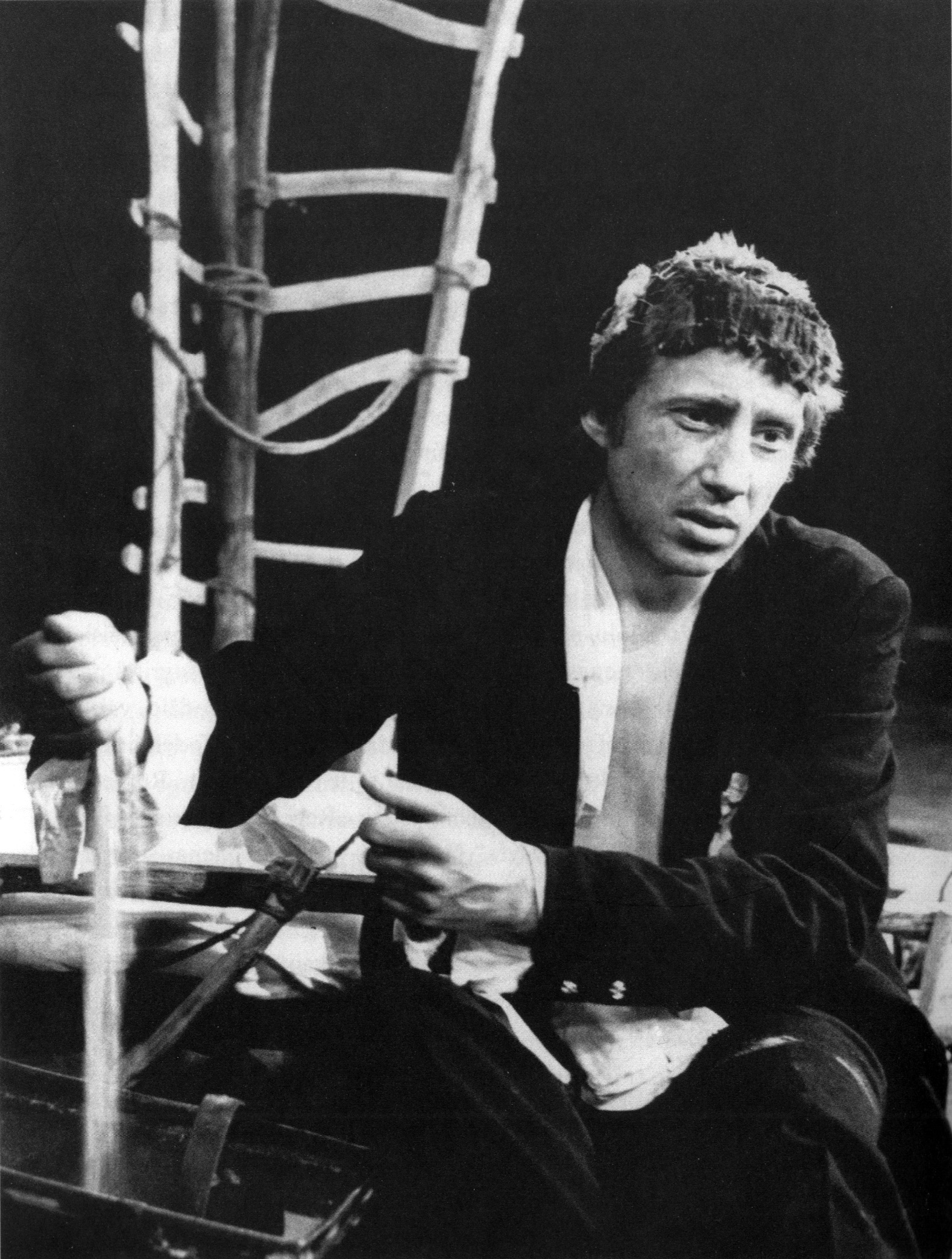
‘The Day Lasts More Than a Hundred Years’; Algirdas Latėnas as Yedegei. Photo: Courtesy of Kultūros barai.
The time and space constructed in the performance acquired epic dimensions: one day of the funeral rites indeed seemed to last a hundred years. Yedegei’s tiny world expanded into a macrocosm, in which, for instance, the surface of the water in a barrel would reflect a spaceship taking off.
During the introduction to the performance, conducted in complete silence, it would take the audience some time to discern Yedegei and Ukubala (Irena Tamošiūnaitė) as they seemed to have merged with the grey dullness of their daily life. Aitmatov had made Burannyi Yedegei the centre of the contemporary world, and Nekrošius entrusted the centre of the epic created on stage to the actor Algirdas Latėnas, who had to control the stream of consciousness of Aitmatov’s narrative and prevent the performance from turning into merely a spectacular spectacle. It seems to be an impossible task, but Latėnas handled it masterfully. Even though Yedegei’s role in Aitmatov’s novel consists mainly of monologues, Latėnas turned them into conversations. There were awkward appeals to the railway station master, who had ruthlessly refused to let Yedegei attend his friend Kazangap’s funeral. There were heartrending tête-à-têtes between Yedegei and his beloved Zaripa (Kristina Kazlauskaitė) as well as his teacher Abutalip (Ferdinandas Jakšys), both lost during the years of Stalinist terror and repressions, and only alive in Yedegei’s memory. There were discussions about history and mythology with mankurts, characters from Kyrgyz legend who were prisoners of war whose heads would be wrapped in camel skin, which would dry and harden under the sun, enslaving them forever and depriving them of the ability to think. Yedegei talked even with his surroundings, including the camel Karanar, a fox, and birds. As the performance progressed, several of Yedegei’s neighbours joined the funeral procession and gave him a white handkerchief so that he, bent under the coffin and in pain, could wipe away his tears. Strange as it may seem, the brightest episode in this sombre performance was Yedegei’s own death. In preparation for it, Yedegei gave away pieces of his last shirt, wrapped in which were handfuls of the sand from the bottom of the drying Aral Sea, considered sacred by the Kyrgyz people. Thereby he reconciled himself with the world and regained peace and harmony.
At the time, many quarrelled over Nekrošius’s take on playwrighting and the text. Some argued that he disrespected the word and literature by over-relying on wordless ‘dramaturgy,’ totally dependent on the director’s choices, thereby usurping the role of the playwright. Defying such criticism, Nekrošius later adapted for the stage an entire library of literary classics: Alexander Pushkin’s little tragedies and Boris Godunov, William Shakespeare’s Hamlet, Macbeth, and Othello, Johann Wolfgang Goethe’s Faust, Anton Chekhov’s Three Sisters, The Seagull, and (for the second time) Ivanov, Lithuanian Kristijonas Donelaitis’ long poem The Seasons (Metai), Fyodor Dostoyevsky’s The Idiot, Dante Alighieri’s entire The Divine Comedy, Franz Kafka’s A Hunger Artist, even the masterpieces of The Old Testament, The Song of Songs and The Book of Job. Nonetheless, even while still at the Youth Theatre, Nekrošius proved his respect for literature and literary classics as well as demonstrating a unique talent in interpreting them.
Uncle Vanya directed by Nekrošius was a modern take on the brutal realism of the late 20th century, perhaps even its radical manifestation. Without denouncing his dramaturgical experiments, this time Nekrošius did not omit a single (!) word from the play and even added some phrases from Chekhov’s other texts, creating a very special harmony between verbal and non-verbal forms of expression.
The plot of the performance was punctuated with directorial pauses. The introduction was meant to foreground the creation of the performance space with actors establishing contact with the stage space and the objects which would become an essential part of the stage design. What I want to call Nekrošius’s ‘liturgy,’ his strategy of turning material objects into suggestive leitmotifs (not unlike bread and wine are turned into flesh and blood), allowed Chekhov’s words to become flesh and make their dwelling among the audience. And I use the term ‘liturgy’ not only as a metaphor: Nekrošius’s Uncle Vanya would begin with a Jewish song, reminiscent of a lament or a prayer, adapted to stage by the director’s ‘brother in arms,’ composer Faustas Latėnas. Who or what was lamented? Who or what was prayed for?
The introductory directorial pause spoke, albeit without words, about sickness and resignation afflicting a tormented soul and an entire world, which had exhausted its possibilities. In the mis-en-scène, doctor Astrov (Kostas Smoriginas) was treating the Nurse (Irena Tamošiūnaitė) by applying suction cups to her back and then, suddenly and surreptitiously, pulled out a bottle of morphine, his only way to endure the debilitating dreariness of the provincial life. As is typical for Nekrošius’s dramaturgy of physical details, the bottle of morphine found its way back on stage in Act Four of the play (the scene between Astrov and Voynitsky), while the suction cups reappeared during the finale: in the final scene, the cups were applied to Uncle Vanya’s (Vidas Petkevičius) back, as it was now his soul that had been overcome with sickness. Life, in the manner typical to Chekhov, had come full circle.
Only the retired professor Serebryakov (Vladas Bagdonas) and his admirer, old Voynitskaya (Elvyra Žebertavičiūtė), did not feel tormented in any way. In Nekrošius’s performance, this grotesque couple was characterised by highly mechanical movements, foregrounding their unwillingness or inability to change their habits: a new life had not yet begun, and the old one continued out of sheer inertia. Serebryakov’s only concern during the performance was not the people living on his estate, nor their destiny, but a heavy metal weight placed on the avant-scène, another image from Nekrošius’s dramaturgy of physical details. When on stage, Serebryakov watched with envy with what ease his friends and rivals, uncle Vanya and doctor Astrov, would lift the weight.
Sonya (Dalia Overaitė) and Yelena Andreyevna (Dalia Storyk) made another pair of friends-rivals. In aging Serebryakov’s provincial estate, his young and beautiful wife Yelena Andreyevna looked like a palm tree among the snow. She was also the centre of the action, even though seemingly against her own will as at one point she acknowledged that she was performing a merely ‘episodic role.’ Everyone on the estate leaned towards Yelena Andreyevna, as if enchanted by her beauty, of which they wanted to steal at least a small part, just like they kept stealing her perfume bottles – another instance of Nekrošius turning words into flesh. Not only the men were guilty of that, but also Sonya, whose long and heavy black braids reached to the floor, as if a pair of mourning sashes. As far as I know, in the history of Chekhov’s theatrical production, no Sonya has been played with so much talent, elevating the character to the status of a tragic figure, on a par with Uncle Vanya.
Differently from the conventional interpretations of the play, Dalia Storyk’s Yelena Andreyevna was not an attractive beast, not a slick beautiful weasel, but a selfish coquette, who rejected and destroyed a wonderful man. In Nekrošius’s performance, everyone got rejected and destroyed, even Yelena Andreyevna herself, repeatedly treated like an object: in one scene, Astrov met her equipped with a pair of pincers; in another one, Serebryakov prodded her with a walking stick.
This world, doomed to disappear, could not be saved by Yelena Andreyevna’s ephemeral beauty, which, just like her exotic perfume, would soon vanish without a trace, and she would remain empty handed and helpless. After the estate went on sale, the residents lined up for the last photograph and sang Va, pensiero, the chorus of the Hebrew slaves from the Giuseppe Verdi’s opera Nabucco. This, arguably, is the most beautiful crowd scene in the entire history of the Lithuanian theatre. And the photograph turned out to be a last record of the dying epoch as the old Soviet system collapsed less than five years later. At the same time, it was a farewell photograph of the troupe of Uncle Vanya, the dream team of the Youth Theatre. The legendary troupe soon fell apart; the actors began their solo careers, each going their own way, seeking the new lands of their dreams, their promised lands.
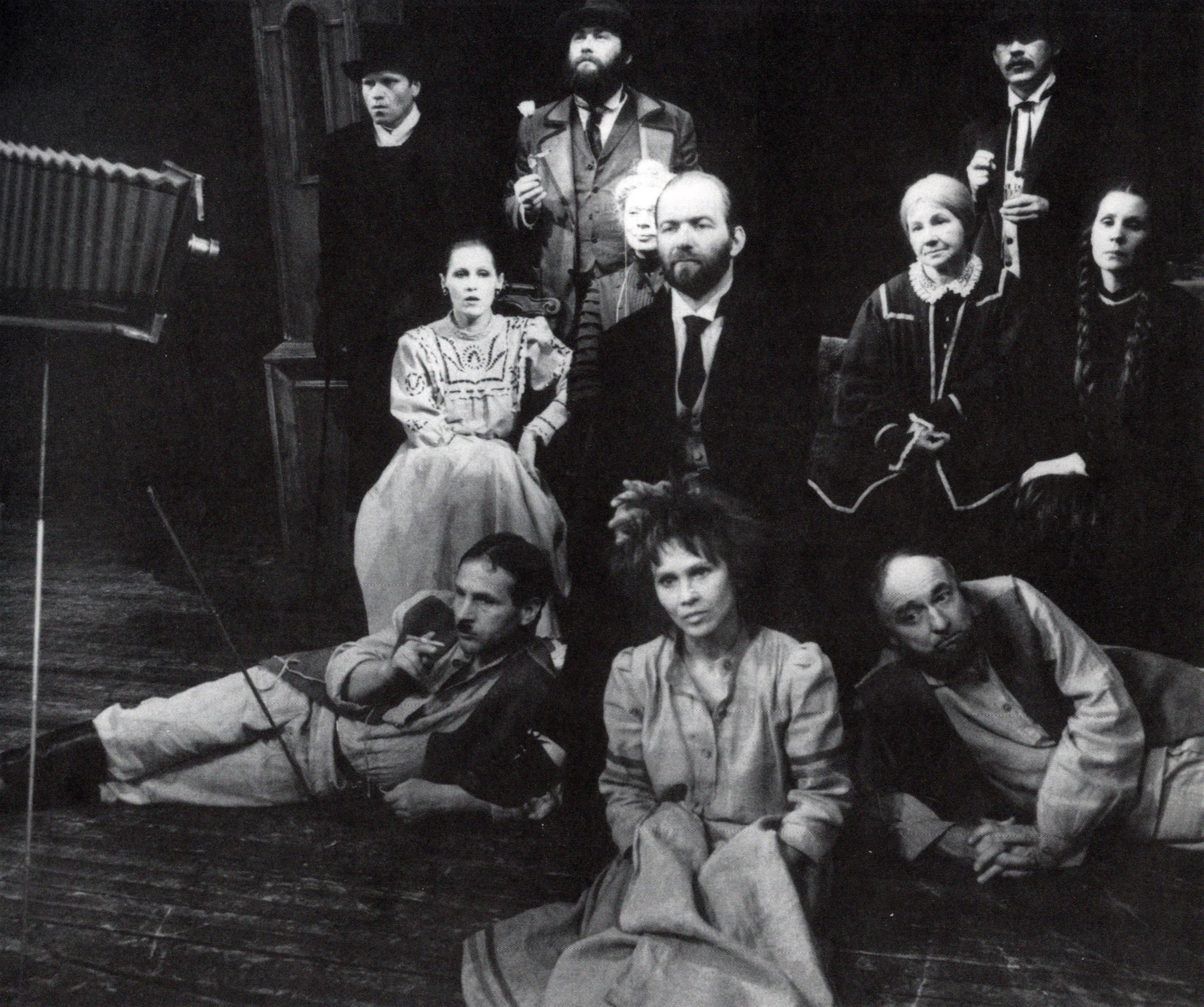
‘Uncle Vanya’; chorus photography scene. Photo courtesy of Kultūros barai.
The prophecies of Doctor Astrov
Even after the demise of the communist dictatorship, Nekrošius’s phenomenon in the Youth Theatre remained without adequate explanation. The Square, a performance about the Soviet man’s ‘freedom without rights,’ was performed in Vilnius, completely, unimpeded, during the very peak of the Soviet stagnation: when attempts were made to rehabilitate Stalinism and the Gulag, because communism could not sustain itself without labour camps; when Stalin’s crimes had become a forbidden topic; when one could not even breath without permission. The censors obviously did not attempt to decipher the title of the performance, even though it was an obvious euphemism for both the prison and the camp surrounded by barbed wire.
The idea of The Square can be most accurately described, drawing on the words of Varlam Shalamov, whose writing was strictly prohibited at the time: ‘The camp is a replica of our life; the camp even resembles the world. There is nothing in it that wouldn’t exist outside, in freedom, in its social and spiritual structures.’ In other words, Nekrošius’s The Square showed that the entire Soviet Union was a gigantic prison, in which even a free person was hardly different from a prisoner.
‘Was it not here, in these prison cells, that the great truth dawned? The cell was constricted, but wasn’t freedom even more constricted?’ These were the questions Alexandr Solzhenitsyn asked in The Gulag Archipelago. Much later, when Solzhenitsyn’s study of the Soviet Gulag became freely available, we suddenly realized that, except of course for the numerous evidence and facts he presented, Solzhenitsyn did not condemn Stalin’s terror more openly than did Zaripa (Kristina Kazlauskaitė) in The Day Lasts More Than a Hundred Years, when she slapped the gigantic portrait of the moustached Senior Murderer, Stalin, in revenge for the death of Abutalip and billions other innocent victims. Maybe, during the Soviet times, we were braver than Solzhenitsyn himself? No, we were not. Maybe the censors were not attentive enough? Maybe they could be deceived? Or negotiated with?
There were, of course, no deceptions or deals. The censors were not inattentive, either. Their requirement was that the Gulag, if referred to, be talked about without words, which is precisely what was done at the Youth Theatre. However, even during Mikhail Gorbachev’s perestroika years, the censorship made it impossible to show The Square and The Day Lasts More Than a Hundred Years outside Lithuania. In 1987, when American theatre professionals were selecting the repertoire for the Youth Theatre’s tour in the USA, Moscow recommended to the Ministry of Culture of the Lithuanian SSR that Smoriginas ‘fall ill,’ so that the American visitors would not be able to see The Square. Nonetheless, the minister of culture, Jonas Bielinis, took personal responsibility and Smoriginas miraculously recovered: The Square was performed for the Americans in secret, in an otherwise empty theatre. Such a cat-and-mouse game can be partly explained with reference to Herbert Marcuse’s discussion of the universal relationship between society (not only totalitarian) and art (high culture): ‘To be sure, the higher culture was always in contradiction with social reality, and only a privileged minority enjoyed its blessing and represented its ideals. These two antagonistic spheres of society have always coexisted; the higher culture has always been accommodating, while the reality was rarely disturbed by its ideals and its truth.’ Marcuse continues, ‘In its advanced positions, it [art] is the Great refusal – the protest against that which is. The modes in which man and things are made to appear, to sing and sound and speak, are modes of refuting, breaking, and recreating their factual existence. But these modes of negation pay tribute to the antagonistic society to which they are linked.’ It is probably because of such ‘tribute’ that attempts were made to tolerate Nekrošius’s modes of brazen refuting.
Moreover, the high art created at the Youth Theatre was never meant to be enjoyed solely by the privileged minority, the élite. Queuing for the tickets overnight became part of the legend of the theatre, and not only a local one. During the theatre’s triumphant second Moscow tour in 1987, crowds stormed the Sovremennik Theatre; mounted police were called to restore order, while those eager to see the Lithuanians perform a play by a Russian cultural icon, Anton Chekhov, were begging for a spare ticket in the nearest subway station.
Nekrošius’s dream (remember the aforementioned chorus of slaves) eventually overcame the borders erected by the censorship: his performances crossed the Iron Curtain and reached the free world despite the restrictions of the Soviet regime. Those born in independent Lithuania can hardly fathom that during the fifty years of the Soviet occupation, Lithuanians, if they were permitted to go abroad at all, had to fly via Moscow. Foreigners, too, could come to Vilnius only via Moscow.
The first international pilgrim to the Youth Theatre was the director of the Belgrade International Theatre Festival (BITEF) Mira Trailovič, a glamorous lady, who, when she stood next to Eimis, in his regular sweater knitted by his mother (most of us, including me, wore handmade sweaters at the time), looked, as Germans would put it, like air from a different planet (Luft von anderem Planeten). Yugoslavia then, indeed, was a different planet to us, and Mira Trailovič took the Youth Theatre there in 1984. BITEF became for the Lithuanians the first window to have opened to the world. In 1988, the Youth Theatre performed at BITEF for the second time. Among the audience there sat Franco Quadri, one of Italy’s most famous theatre critics, who subsequently became Nekrošius’s good friend and patron in Italy.
Nonetheless, the strongest impetus for the Youth Theatre’s international career was given by famous American playwright Arthur Miller. In 1985, he was attending a meeting between Soviet and American writers in Moscow and had an opportunity to visit Vilnius, where he saw several performances directed by Nekrošius. Upon his return to the USA, Miller told his colleagues about the peculiar Lithuanian theatre genius. Soon after, the Youth Theatre was visited by Edith Markson, an influential figure in the US theatre world. She came accompanied by a group of American theatre directors and producers. A little later, Bernard Sahlins, the director of the Chicago International Theatre Festival, and several directors from the Alley Theatre in Houston arrived. The Chicago festival and the Houston theatre selected Pirosmani, Pirosmani… and Uncle Vanya, and agreed to cover the expenses of the Youth Theatre’s watershed tour in the USA in May 1988.
The Berlin Wall was still standing, and Sąjūdis, the Reform Movement of Lithuania, which led the struggle for Lithuania’s independence, had not yet been created. Therefore, the first tour of the Youth Theatre in the United States (the second one took place in 1990) was more than a cultural event: it was Lithuania’s first escape from a cage, the Soviet ‘square’. It was a hopeful message to the nation that the Iron Curtain was not forever, that it might soon be withdrawn and trips to the West could become a regular thing. Thus the thirty five people from the Youth Theatre set off to the USA as if carried by the wings of Lituanica, the aeroplane flown from New York across the Atlantic Ocean by Lithuanian pilots Steponas Darius and Stasys Girėnas’s in 1933. It is quite symbolic that Eimuntas Nekrošius had starred as Stasys Girėnas in Raimondas Vabalas’s film A Flight Over the Atlantic (Skrydis per Atlantą) (1983), which narrates the story of Darius and Girėnas’s endeavour.
The theatres were full. The English-speaking audiences watched with rapt attention and applauded enthusiastically for the actors, performing in Lithuanian – in fact, only in the theatre did many in the audience find out that Lithuanians are not Russians. Extremely positive reviews were published in the American press. All in all, it was a stupendous success. Lithuanian-American Arūnas Čiuberkis did a fabulous job as a translator. He and another compatriot, the wonderful Audra Misiūnienė, who volunteered to manage the tour, became true members of the troupe. It was an international triumph not only for the Youth Theatre but for the entire country, then still under the Soviet regime.
The tour was also important as a historical and purely political event as it united, for the first time, two parts of the nation, violently split by the Soviets: that which remained in the occupied Lithuania and that which had found refuge in the free world. The majority of the organisations created by the Lithuanian diaspora in the USA strictly complied with the policy of withdrawal and did not foster any connections with the Lithuanian SSR. They would boycott or even picket the sparse representatives of culture and arts from the homeland, because these visits, aimed exclusively at Lithuanian audiences in the US, were correctly seen as propaganda campaigns or even spying, conducted by the association Tėviškė (Homeland), essentially a KGB institution. By contrast, the tour of the Youth Theatre was arranged through the Ministry of Culture of the Soviet Union and its commercial institution Mosconcert, thereby bypassing the involvement of Tėviškė as well as avoiding the danger of being seen as yet another propaganda campaign celebrating the ‘achievements’ of Soviet Lithuania.
This allowed the Youth Theatre to be received with warm welcomes by various political organisations of Lithuanian Americans, even those who usually abstained from any official contacts with the Lithuanian SSR, because these threatened the anti-communist resistance movement and the politics of non-recognition of the occupation as well as eroded the unity of the diaspora in exile. The power of the art of the Youth Theatre helped demolish the wall of distrust which loomed large between the two artificially antagonised parts of the nation.
Sooner or later, any legend comes to an end, even if art is as ephemeral as theatre is. However, thirty years later, I can remember one of the scenes from Uncle Vanya in the tiniest details: Doctor Astrov (Kostas Smoriginas) shows Yelena Andreyevna (Dalia Storyk) a cartogram of his own making, detailing how the district looked 50 and 25 years ago, and how it looks now, and delivers a harsh diagnosis: ‘Overall, this picture shows a gradual and certain degeneration, which, some 10 or 15 years later, will most probably become universal.’
More than 10 or 15 years have passed since Uncle Vanya premiered at the Youth Theatre. Has Astrov’s prophecy come true? We need (I do!) to look at Eimuntas Nekrošius’s magic screen once again, that gigantic magnifying glass which would show us the real picture of our contemporary existence.







